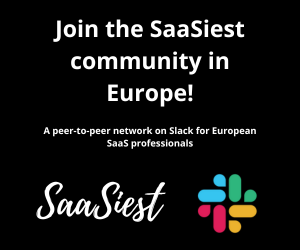Onboarding is broken – and it’s costing you more than you think
In fast-growing SaaS companies, onboarding is often treated like a one-off support task. A welcome email, a Zoom session, a few help docs.
The result? Most users drop off before they ever experience your product’s value.
Pendo reports that 70% of software users churn within the first three months. Once they’re gone, it’s hard and expensive to win them back. This isn’t just a customer success issue. It’s a business growth problem.
Courtney Librizi Marline, Head of User Engagement at Kognity, has built onboarding strategies that drive meaningful business outcomes, resulting in higher adoption, stronger retention, and increased revenue.
At SaaSiest 2025, she laid out the key mistakes most companies are making, and what to do instead.
Meet Courtney
At Kognity, Courtney leads onboarding and user engagement for thousands of educators. These users often work within complex decision-making structures and experience high turnover. Courtney and her team have designed scalable onboarding programs that meet the real-world needs of both decision-makers and end users.
Her work blends product-led growth, customer success, and instructional design—making her a powerful voice on what effective onboarding really looks like today.
The mindset shift: Onboarding is customer education
Courtney’s playbook starts with a simple but powerful idea:
“Onboarding isn’t a session. It’s a journey.“
To drive growth, onboarding must be treated with the same care and investment as sales or product development. Here’s how she recommends approaching it.
Step 1: Focus on users, not just customers
The person who signed the contract isn’t always the person using the product every day.
Too often, onboarding is designed for the economic buyer instead of the end user. That’s where things fall apart.
Courtney stresses the importance of separating customer success metrics from user success metrics. Because if the onboarding experience doesn’t speak to the user’s actual day-to-day goals, they’ll disengage.
For example:
- A school district may want better student performance, but an individual teacher just wants fewer distractions in class.
- A CFO might look for consolidated reporting, while a department head just wants to quickly check their team’s budget.
When onboarding speaks only to strategic goals, users lose interest. And if users don’t adopt the product, your retention numbers suffer.
Take action:
- Map user personas and define what “success” looks like for each role.
- Focus onboarding on the user’s day-to-day goals, not just the buyer’s.
- Get users to their first “aha” moment as quickly as possible.

Step 2: Teach workflows, not features
Most onboarding walks users through every feature. But users don’t care about features. They care about outcomes.
Courtney puts it simply: onboarding is your chance to sell to users. Many weren’t involved in the purchase decision. You need to win their buy-in by showing them how the product helps them solve real problems.
Her value-first approach includes four key principles:
- Relevance: Focus on what the user actually wants to achieve.
- Engagement: Group content by outcome, not by navigation tabs.
- Stickiness: Teach through problem-solving, not button clicking.
- Lean delivery: Cut anything that doesn’t get the user to value quickly.
What to do:
- Build onboarding around common workflows, not feature lists.
- Drop unused or low-impact features from early-stage education.
- Remove any friction between the user and their first success.
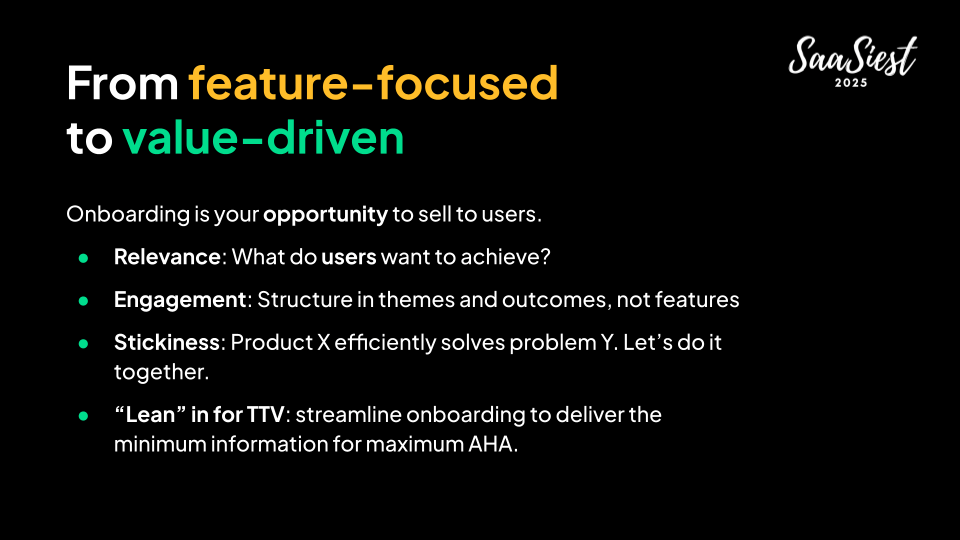
Step 3: Design onboarding for how people learn
A single training call won’t drive real adoption. Your onboarding should be designed like a learning experience, not a support ticket.
Courtney recommends using instructional design principles to make onboarding stick. Here are the ones she highlights:
- Spaced repetition: Reinforce concepts over time, not all at once.
- Microlearning and upskilling: Keep it short and digestible.
- Just-in-time learning: Deliver content when it’s most relevant.
- Active learning: Prompt interaction, not passive watching.
- Motivation loops: Show visible progress with goals or checklists.
It’s not about content volume. It’s about when and how you deliver it.
What to do:
- Use in-app guidance, short videos, and tooltips to layer learning.
- Space your onboarding over the first 30 to 90 days.
- Build small moments that feel easy but unlock value fast.
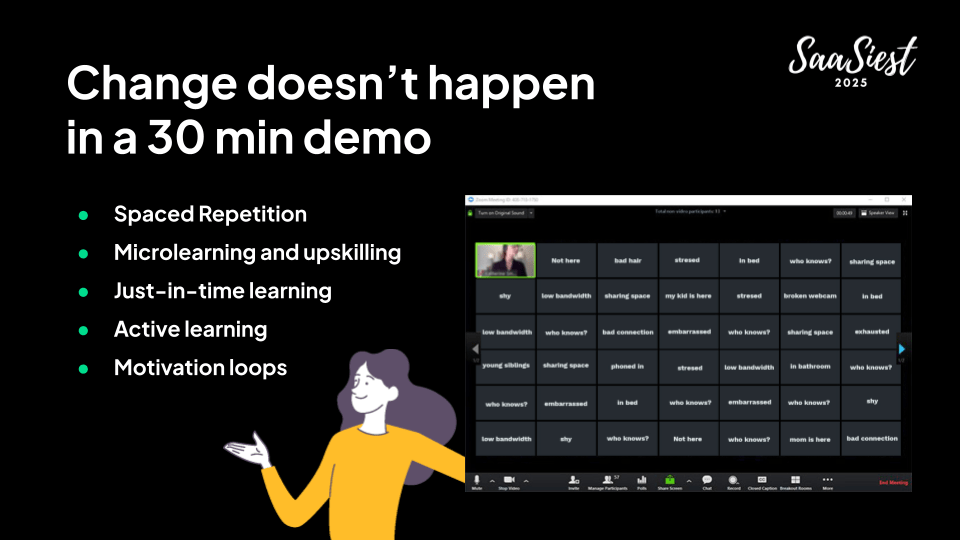
Step 4: Plan for internal churn
SaaS companies often overlook the importance of onboarding new users within existing customer accounts.
Employee turnover is real. In some industries, up to 20% of users leave their roles every year. If you’re not continuously onboarding, you’re likely serving untrained users who never had proper guidance.
Take action:
- Provide scalable, self-serve onboarding resources for existing accounts.
- Build triggers into your CRM to re-engage or re-onboard new users.
- Keep track of champion loss and plan for it in your customer success strategy.
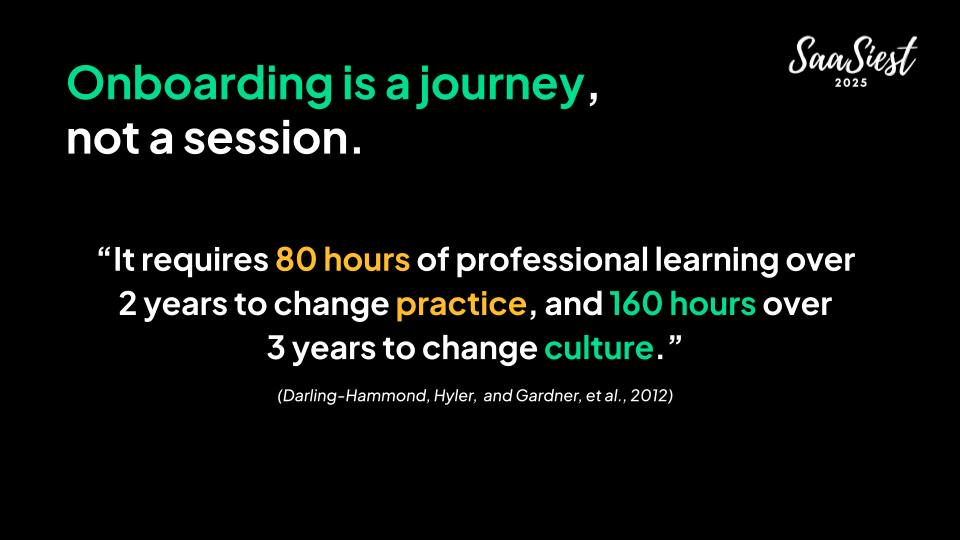
Step 5: Make onboarding scalable and relevant
Not every company can afford a team of full-time trainers. But everyone can create scalable systems.
Courtney’s team uses a mix of tools and formats to meet users where they are:
- In-app guides and walkthroughs
- Short-form videos and one-minute explainers
- Podcasts and blog-style learning for passive consumption
- Customer stories that showcase successful workflows
And they personalize everything. The right content, at the right time, for the right user.
Take action:
- Personalize onboarding flows based on role, behavior, or stage.
- Leverage your community to amplify learning and share best practices.
- Track engagement across formats and double down on what works.

The results? Real business impact
When onboarding is done right, the payoff is significant.
- McKinsey found that better onboarding can reduce churn by 14%.
- You lower your CAC payback period because users activate earlier.
- Retention goes up. So do upsell opportunities.
- You avoid the costly and frustrating “win back” phase.
Courtney’s advice: Don’t wait to fix this later. The first 90 days are where it matters most. If you don’t capture users then, it will cost you exponentially more to re-engage them down the line.
Your Onboarding Playbook
If you’re building or rebuilding onboarding, start here:
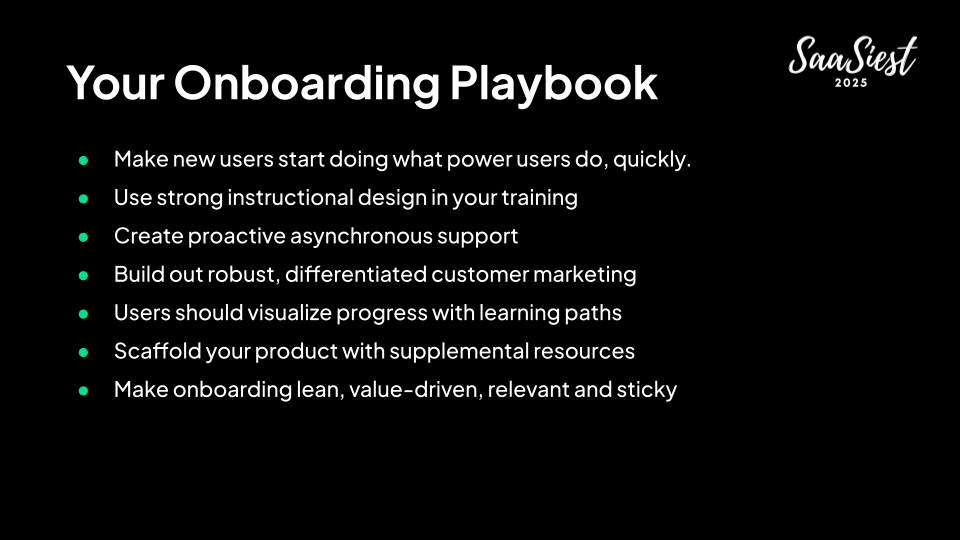
Final takeaway: Teach them well, and they’ll stay
If you want to reduce churn, increase retention, and unlock expansion, onboarding isn’t optional. It’s strategic.
Meet users where they are. Help them solve real problems. Make them feel capable and confident.
Because when users learn well, they stick around. And when they succeed, so do you.
Check out Courtney’s session at SaaSiest 2025 here



